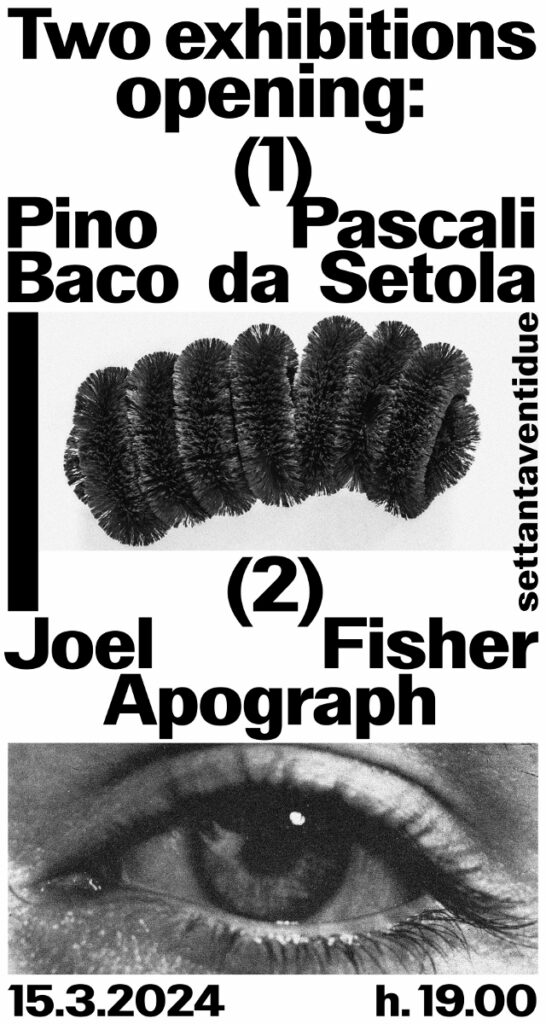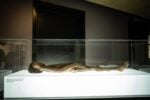Pino Pascali / Joel Fisher

Mostra doppia personale.
Comunicato stampa
settantaventidue invites you to the Opening of the exhibitionsPino Pascali - Baco da Setolacurated by Nicola Mafessoni & Daniel Marzona&Joel Fisher - ApographFriday the 15th of March 2024 19:00-21:00 Via Lodovico il Moro 1, Milano
|
|
|
PINO PASCALI Baco da setola Between May 19th and June15th 1976, the exhibition 500 Artists for Innocenti and for the Other Occupied Factories was held at the Palazzo della Permanente in Milan. It was promoted by FIM, FIOM and UILM and curatedby Ciacia Nicastro (the wife of the art historian Tommaso Trini) withlegal support from the lawyer Enrica Domeneghetti Smuraglia. The works exhibited "as a mobilization of culture for the workers in the struggle", as can be read in the leaflet, were put up for sale through a lottery with tickets which gave the winner priority in choosing the works themselves. The tickets, based on a sort of subscription, were purchased by numerous municipal administrations and by a group of gallery owners (including Galleria Martano, Levante, Lambert, Artecentro, Montrasio, Chiocciola, Vismara and others) who offered them to their collectors. Among the 500 works mentioned in the leaflet, the work by Pino Pascali is indicated as “sculpture-object of mixed materials”. The work “Baco da Setola” (1968) was acquired on that occasion by a collector and remained in his collection until 2021. The work belongs to Pascali's renowned series of sculptures inspired by the natural world. Its title "Baco da Setola" can be literally translated as "bristleworm" in English but in Italian is in fact a delicate play on words between the term “baco da seta” which means silkworm and the word “setola” which means bristles, such as those used in pipe cleaner brushes. Using industrial materials such as metal and acrylic bristles, Pascali's "Baco da Setola" challenges traditional notions of sculpture through appropriation and metamorphosis and redefines the boundaries between art and everyday objects. The sculpture's intricate form and meticulous attention to detail evoke a sense of wonder and fascination, inviting viewers to explore its complex form and texture. JOEL FISHER Apograph apograph (noun), ap·o·graph ˈapəˌgraf: copy, transcript.
I gathered together from various locations all my paper works which had not been sold, and assembled them in chronological order. I pulped down this material, and from it made as many sheets of paper as possible.The destroyed works included pieces from each of the seven years I had been making paper. I had never intended to reject these works, and yet all these pieces were to be destroyed. The action was irrevocable. My only interest had been to pull all the pieces together. Radically. The old papers had been pulped and added to the vat in their original chronological order. After each new paper was made, a small amount of fresh pulp was poured into the vat. This new material brought about changes of colour in the following sheets. The result is what you see here: it is a final simplicity, a relative simplicity. The layered sheets remind me of the sequence in which the papers rise, one at a time, from the water. The layering implies potential and reinforces the form. The sheets of paper take the form of the papermould. The moulds I use are usually rectangles, but the papers never conform accurately to this form. Usually the edges of the paper are not straight lines. Sometimes the sheets are eccentricly irregular. Paper is a medium of, as it were, a material reincarnation; keeping, as it does, a memory of the vat. Its immediate past is one of paper's potentials. Caught between fragile memory and abundant potentials there is also something quite surprising to perceive: a blank sheet of paper is a very beautiful object. Joel Fisher
|
|
|
|
|
|
Conceptual and minimal art, electroacoustic experimentation, sound art and field recording, radical and utopian architecture, are at the centre settantaventidue’s program. settantaventidue is committed to an articulated and rigorous cultural proposal, concentrating specifically on experimentation and research in the fields of visual, sonic and architectural arts with determined and consistent trajectories estranged from mainstream culture, conventional artistic discourses, and market dynamics.
All of settantaventidue’s cultural activities are entirely organized and financed by the non-profit entity Umbra Grey ETS, thanks to the generous collaboration of:
Main partner and supporter: Kira A. Princess of Prussia Foundation, Germany
Partners: Zurich Insurance Plc Italia & Consulenze Assicurative srl-Brescia |



